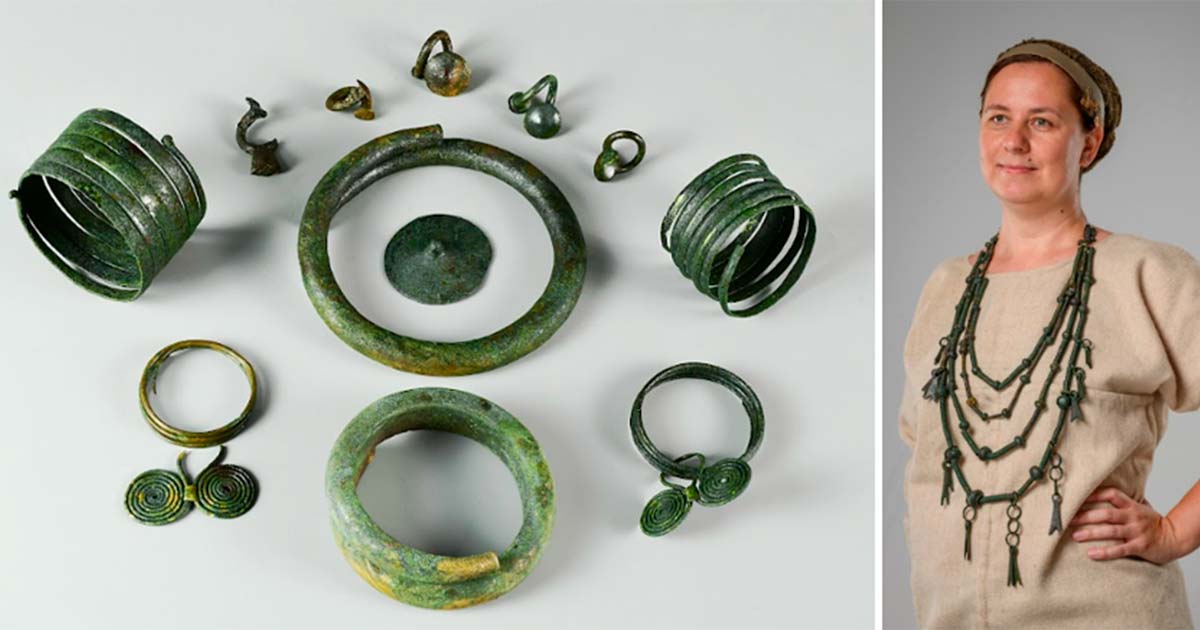A Dry Lakebed Site Shows Revolutionary Bronze Age CheĂmno Culture Jewelry

Archaeologists in Poland have unearthed a trove of over 550 pieces of Bronze Age jewelry believed to have been part of an ancient burial ceremony. Discovered at the Papowo Biskupie site, which was once a dried-out lakebed, the artifacts provide a window into the practices of the Chełmno group, a community within the larger Lusatian culture occupying the region from the period of 3000 to 2000 years ago. Its association with human remains suggests a profound link between burial rituals and the deposition of metal objects.
A Traditionally Sacred Relationship With Metal
Occupying the area from approximately 1200 to 450 BC, the Chełmno group resided in northern Europe during the Late Bronze Age and Early Iron Age. Traditionally, the Lusatian culture is renowned for its ritualistic deposition of metal hoards in water bodies. Surprisingly, the Chełmno group was not previously associated with this custom, seemingly assigning less ritual significance to metal. However, the groundbreaking discovery made by metal detectorists in 2023 has challenged this perception, and is the subject of a new study published in Antiquity.
“The scale of metal consumption at the site is extraordinary,” study co-author Łukasz Kowalski, a postdoctoral researcher of archaeology at the AGH University of Science and Technology of Krakow, told Live Science over email. “Until now, we thought that metal was a weak partner in the social and ritual strategies of the Chełmno group, in contrast with the metal-hoarding madness [practiced by the other Lusatians].”
Researchers also recovered skeletal remains from at least 33 human bodies, spanning various age groups from infants to adults, within the lakebed. Radiocarbon testing placed the bones’ origins between 1040 and 780 BC.

Conceptualised reconstruction of the necklace recovered from Papowo Biskupie. (A. Fisz/Antiquity Publications Ltd)
A Hint of Long-Distance Trade Networks
Among the artifacts unearthed at the site are arm and neck adornments, including a necklace featuring oval- and tube-shaped beads, as well as “swallow-tail pendants.” The researchers speculate that many of these metal pieces were crafted by local artisans. However, one glass bead found in the same necklace seems to have originated from a more distant location, providing valuable insights into the community’s engagement in trade networks, according to a press release.
“The bead is made of low-magnesium glass that was sourced from the Eastern Mediterranean region,” Kowalski tells Live Science. “This increases the use of evidence that power-elites of the Chełmno group became parties to a metal trading network that connected much of the European continent in the first millennium BC”.
The majority of the metalwork discovered consists of arm and neck jewelry. Based on these findings, researchers reconstructed a possible outfit worn by a woman of the Chełmno group (pictured above). The researchers concluded their study with illustrated depictions imagining how a Chełmno woman’s burial might have been arranged. One of these illustrations portrays her lying down with her head turned to the side, adorned with some of the metal jewelry retrieved from the site.

Hypothetical reconstruction of a female outfit based on metal dress fittings and jewelry deposited at Papowo Biskupie (A. Fisz/Antiquity Publications Ltd)
A Larger Divergence and Convergence?
Radiocarbon dating suggests that the placement of human remains in the lake predated the deposition of metal, indicating the possibility that the Chełmno community initially buried their dead in lakes before transitioning to metal votive deposits.
Crucially, the association of human remains with the metal deposits suggests that although the Chełmno group initially diverged from the rest of the Lusatian culture in their ritual practices, their belief system eventually aligned with that of the broader region.
According to the authors, this single discovery has fundamentally altered the perception of the Chełmno group, highlighting the site at Papowo Biskupie as one of the most compelling testimonies of ritual activity from the Lusatian period in Poland.
“Our discovery opens a new window for exploring the social and ritual practices of the Chełmno group and reflects the complex interplay between deposition of human remains and metal objects in wetlands. This discovery may signal how metal and human depositions could be used to regulate social relations in the Chełmno group and to demonstrate their local identity,” concluded Kowalski.